Hanfu wedding, which is wearing traditional Chinese clothing: Hanfu, and taking the traditional Chinese wedding system as the prototype.
Modern people restore the traditional Chinese wedding, they roughly sum it up as follows
- The Zhou Hanfu wedding (周制婚礼), represented by the pre-Qin and Han Dynasties.
- Tang Hanfu wedding (唐制婚礼) represented by Wei, Jin, and Tang Dynasties.
- Ming Hanfu wedding (明制婚礼) represented by song and Ming Dynasties.
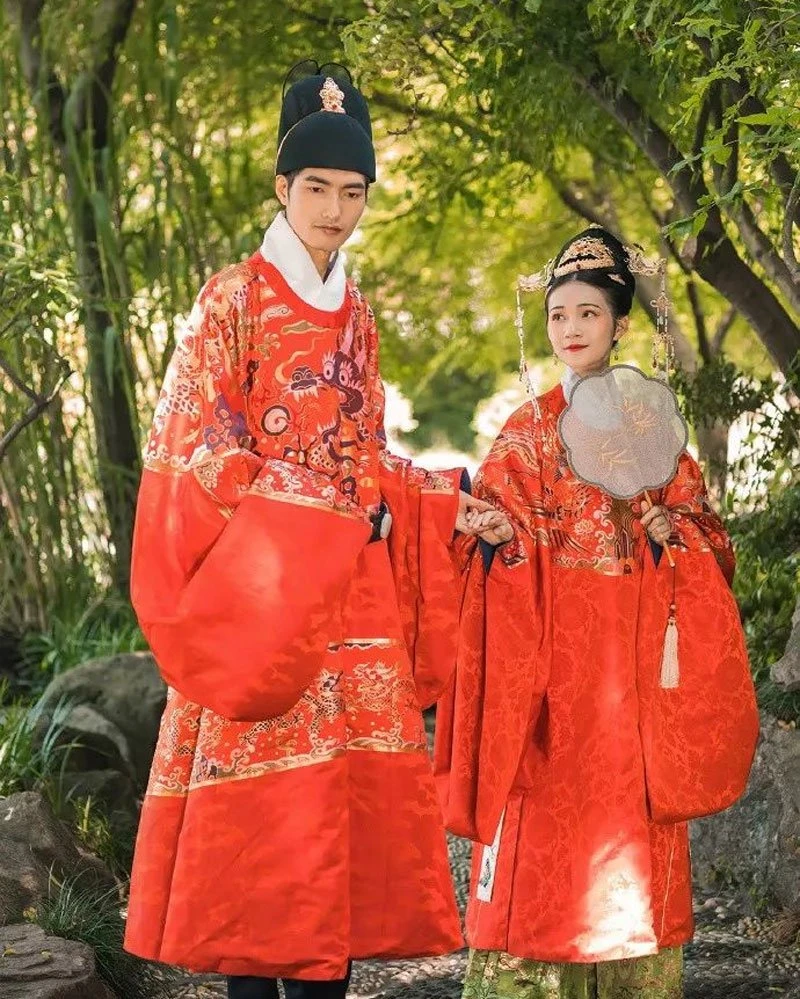
As we all know, culture is the life of a nation, and etiquette is one of the main signs of all civilized nations and an important window of national culture. As the Chinese nation with a long civilization of 5000 years, attach great importance to marriage.
The book of Zhouyi said: Only when there are heaven and earth can there be everything. Only when there is everything can there be men and women. Only when there are men and women can there be couples. Only when there are couples can there be fathers and sons. Only when there are fathers and sons can there be princes and ministers. Only when there are princes and ministers can there be ups and downs. That is to say, all human relations begin with the couple. Therefore, the ancients believed that marriage is the basis of ethical relations.
Due to the progress and great changes in society, it is impossible to return to the pre-Qin wedding completely. The wedding ceremony and custom in each historical period are not only in the same line, but also have their own charm.
- The Hanfu wedding system of the Zhou follows the ritual system of the Zhou Dynasty, wearing the wedding dress of the Zhou Dynasty, which is classic, elegant and solemn;
- The Hanfu wedding system of Tang followed the rites of the Zhou Dynasty with great momentum. Due to the opening up of the country and the increase of international exchanges at that time, the overall form was also relatively lively;
- The Hanfu wedding system of the Ming Dynasty inherited the etiquette of the Ming Dynasty, dressed in the wedding dress of the Ming Dynasty, and the bride dressed in the Phoenix crown, which was gorgeous.
- For a special introduction to the wedding of Hanfu, click this article: What is Traditional Chinese Wedding Dress?
Zhou Hanfu Wedding(周制婚礼)
Zhou Hanfu wedding is the prototype of the Chinese wedding, and the later Han wedding gradually evolved on the basis of the Zhou wedding. The ceremony was solemn and elegant, fully reflecting the ancient charm of the Chinese wedding culture. Weekly weddings don't play music or celebrate. Wedding emphasis is placed on the etiquette and feelings between husband and wife. It's not a noisy thing.
Pre-wedding Ceremony
Pre-wedding ceremony: Nacai (纳采) → Wenming (问名) → Naji (纳吉) → Nazheng (纳征) → Ask marriage date (请期) → Qinying (亲迎).
Nacai (纳采, access to the woman's home through the matchmaker)
Nacai is to discuss marriage. The man wants to marry the woman. The man sends his matchmaker to the woman to propose marriage. Use wild geese as meeting gifts.
There are three symbolic meanings of the ceremony of wild geese:
- Wild geese are migratory birds, flying south in autumn and returning North in spring. They never lose a season, so wild geese are used to symbolize that both men and women are faithful.
- The geese are in line when they are migrating and flying. The strong geese lead the way, while the young and the weak follow, never surpass. Apply this principle to marriage. The elder and the younger should be married in order.
- Because the wild geese's spouse is dedicated to life, it symbolizes loyalty and a long life together.
Wenming (问名, ask name)
After asking for the women's consent, they will have Wenming ceremony. The husband's family decides whether to get married or not through divination and what are the good and bad luck. Generally, they ask for information such as women's name, rank, date and time of birth.
Naji (纳吉, confirm marriage)
The purpose of Wenming is to prepare Naji. After divination, if get auspicious omens, send the matchmaker to the women's home to report the auspicious results. After Naji, the marriage will be officially determined.
Nazheng (纳征, preparation of betrothal gifts)
Nazheng is often the key to marriage. Betrothal gifts are sent to the bride's house. After Nazheng, the marriage enters the formal preparation stage.
Ask marriage date (请期)
The agreement between the bride's and groom's families on the date of the wedding. Groom's family choose their wedding dates, and the matchmaker goes to the bride's house to discuss the date of the wedding.
Qinying (亲迎, send a party to escort the bride to the groom's house)
On the wedding day, the bridegroom goes to marry his bride. The bride's parents made a feast at home and welcomed the bridegroom outside. The bridegroom used wild geese as a gift.
After receiving the bride, take care of the bride and get on the carriage. Then the bridegroom drove the carriage by himself and let it rotate three times before he handed it to the coachman and walked ahead in another carriage. At the door of the bridegroom's house, the bridegroom gets out of the car first and waits. When the bride's car arrives, the bridegroom leads the bride into the house, and the bride enters the house, and the pre-wedding ceremony is over.
Formal Wedding Ceremony
After the bride is received into the bridegroom's house, the ceremony of formal marriage is held.
Formal wedding ceremony: Woguan (沃盥) →Duixi (对席) →Tonglao Hejin (同牢合卺) → Junyu Sheren (餕余设袵).
Woguan (沃盥)
The bride and groom must wash their hands and face before entering the wedding hall, which means to wash away the dust and live a relaxed life.
Duixi (对席)
Newlyweds should sit opposite each other. The bridegroom is in the west seat, and the bride is in the East seat.
Tonglao Hejin (同牢合卺)
Tonglao (同牢), newlyweds eat meat from the same animal together;
Hejin (合卺), it means that the newlyweds drink half a glass of wine first, and then exchange the glasses and drink it all at once. It not only symbolizes that the husband and wife will get married forever, but also has the deep meaning of making the bride and bridegroom share weal and woe.
Tonglao Hejin is the most socially significant part of a wedding. It is a necessary ceremony for every newlywed couple.
Junyu Sheren (餕余设袵)
This is commonly known as the bed ceremony, officially become a husband and wife. The bride's and groom's undressing is accepted by the waitress, and the bridegroom takes off the cover of the bride's head. At this time, the waitress comes out with a candle. After that, both men and women formally married.
Post-wedding Ceremony
After the marriage ceremony, the bride becomes a part of the new family.
post wedding ceremony: Fujian Jiugu (妇见舅姑) → Fukui Jiugu (妇馈舅姑) → Jiugu Xiangfu (舅姑飨妇).
Fujian Jiugu (妇见舅姑, bride prepare breakfast for new parents)
The bride calls her husband's father "Jiu" and her mother "Gu", the next morning after the wedding, the bride gets up early and bathes. The bride takes the bamboo with Chinese date (枣) and chestnuts and waits outside Jiu and Gu's bedroom door.
Fukui Jiugu (妇馈舅姑, serve the new parents for breakfast)
The ceremony of "Fukui Jiugu" is followed by "Fujian Jiugu". The bride herself serves the Jiu and Gu to eat. After finished eating, the bride should eat the rest of the Jiu and Gu's food symbolically to show respect and filial piety. Another said, "Fukui Jiugu" means that on the third day after the wedding, the bride will cook in the kitchen to be filial to new parents.
Jiugu Xiangfu (舅姑飨妇, love of new parents)
Jiu and Gu treat the bride with wine and food to show the care of the elders.
Zhou Wedding's Full Dress
The Hanfu wedding dress has always been a very important part of weddings. There are different changes in the wedding dress of previous dynasties, which is also the epitome of the changes in the clothing of traditional Chinese female.
At that time, the wedding dress was not the red that people misunderstood, but the solemn Xuan color dress (Xuan color, with slight red in the black, is the most sacred color.)
The whole ceremony was peaceful. But there's a powerful force in the quiet and meticulous rituals - maybe that's what we want to capture today. The quiet and beautiful ceremony reflects a long lost civilization - the pure, beautiful and Great Han civilization. The marriage system of the Zhou Dynasty advocates elegance and decency, and has a strong sacred feeling and symbolic significance. Therefore, until the Song Dynasty, the system of the Zhou Dynasty was strictly followed.
Tang Hanfu Wedding(唐制婚礼)
There are many similarities between Tang Hanfu wedding and Zhou Hanfu wedding, but with the development of history, there are also some new changes.
Tang Wedding Details
On the day of welcoming the bride, the groom led the drum band, the honor guard and sedan(轿子) to the bride's house, which was very lively along the way. Before the bride gets on the sedan, she dresses up in her boudoir. At this time, there is a process of urging makeup and poetry of urging makeup. Generally, the groom sings by himself or the guests do the work. After leaving the boudoir, the bride should step over the saddle to show that the family wishes her a safe journey to her husband's home and a smooth arrival.
When the bride arrives at the bridegroom's house, people other than her parents need to go out the back door and come back from the front door, which means to follow the bride's footsteps. After the bride enters the door, she first worships the stove, then the gods and ancestors, and then the husband and wife pay homage. In the Tang Dynasty, the bride not only paid homage to her parents-in-law and her husband's elders, but also to the guests.
And then there's rough horseplay at weddings (闹洞房), then the newlyweds enter the new house to drink the joyous wine together, which will be called "drinking wine". The bridegroom and bride once more bowed to each other, and then sat on the bed, right of the bridegroom and left of the bride. At this time, a large group of women began to sprinkle money, which was engraved with the words "longevity and wealth". At this point, the wedding ceremony ended.
Tang Wedding's Full Dress
In ancient times, the use of color was particular and hierarchical. In short, in ancient times, when a man was an official, the dress is red, representing status and identity, and women wear green clothes and draw beautiful eyebrows. Some people think this is the origin of the red Chinese wedding dress.
Therefore, in the Tang wedding ceremony, the bridegroom usually wears red wedding clothes, while the bride wears green wedding clothes, bold color matching collision, reflecting the gorgeous Tang Dynasty atmosphere. Ruqun also became popular in the Tang Dynasty.
Ming Hanfu Wedding(明制婚礼)
Ming Wedding Details
The Hanfu wedding ceremony of the Ming Dynasty mainly includes Nacai (纳采), worship heaven and earth, rough horseplay at weddings, feast, worship new parents the next day, etc.
Features: the morning ceremony, noisy and luxury, large-scale feast.
Ming Wedding's Full Dress
If the bridegroom is dressed in a Shenyi, the bride should wear a Beizi; The bridegroom can also wear a round-necked robe, while the bride can wear a phoenix crown, a large sleeved garment or a round-necked garment and a big red pleated skirt.
Now more and more young people are learning and adding the etiquette of Hanfu to their wedding, which is not only full of the sense of ceremony, but also embodies the expectation and love for the other half in the details.
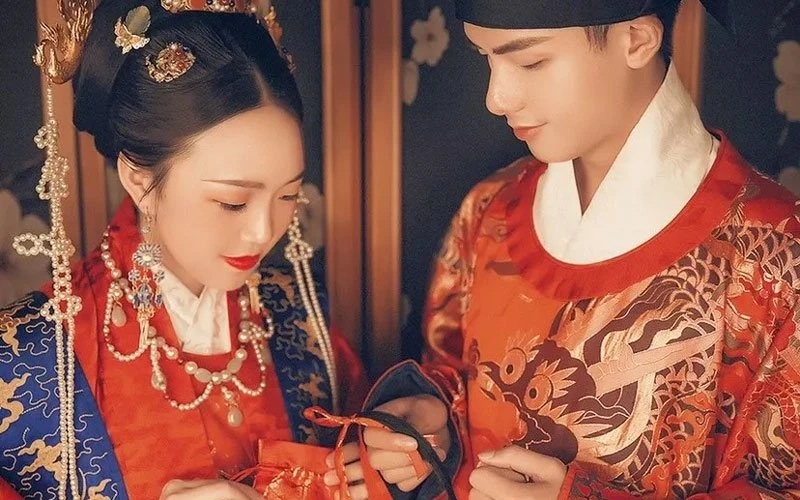
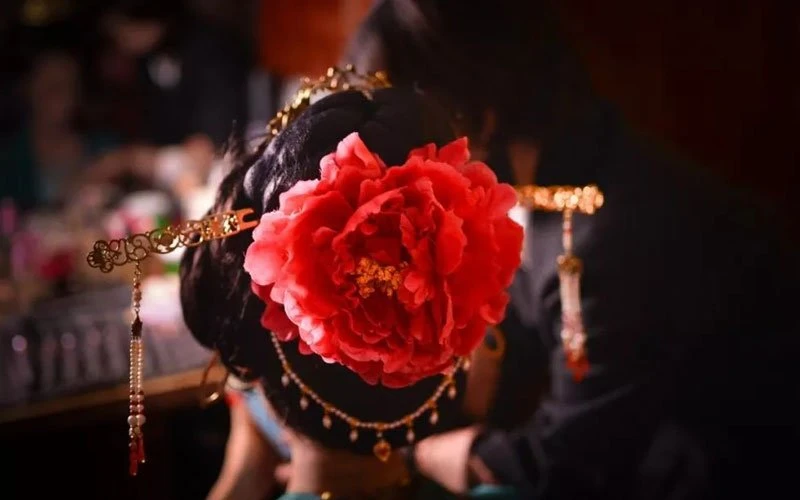

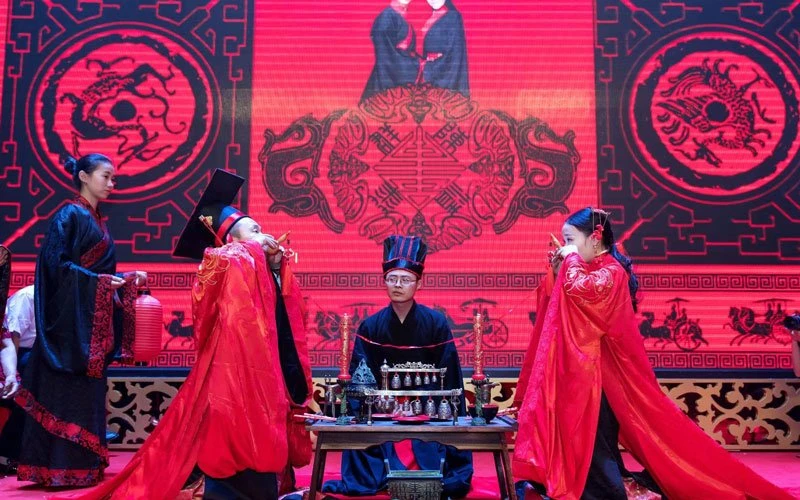
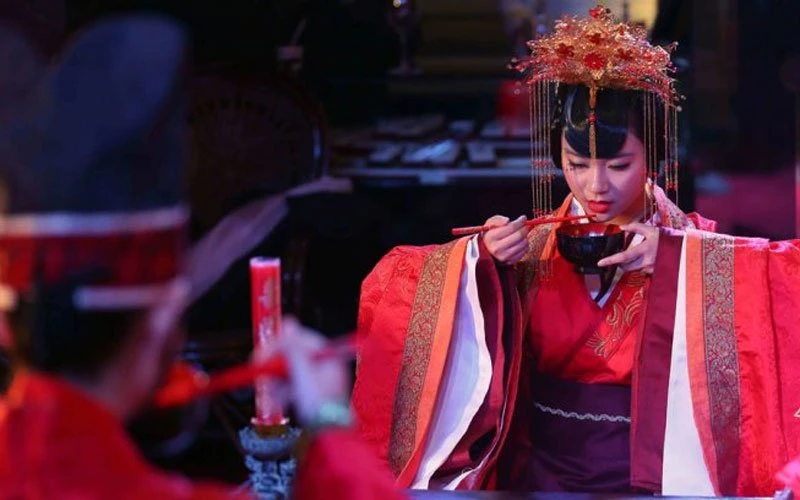
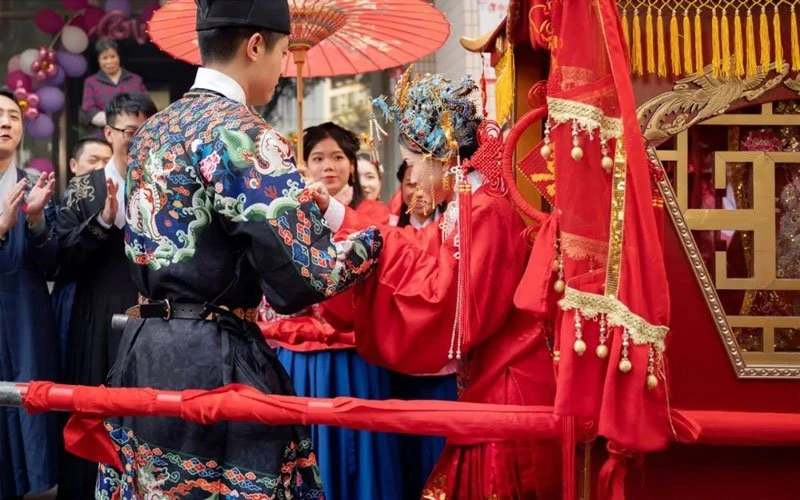
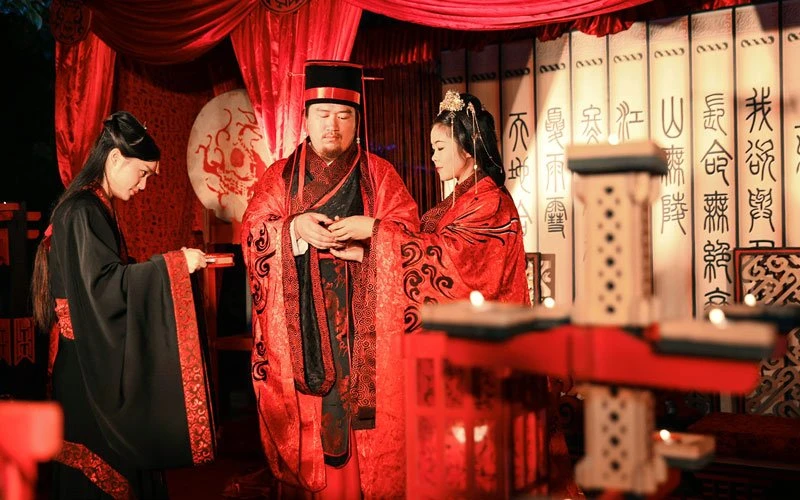
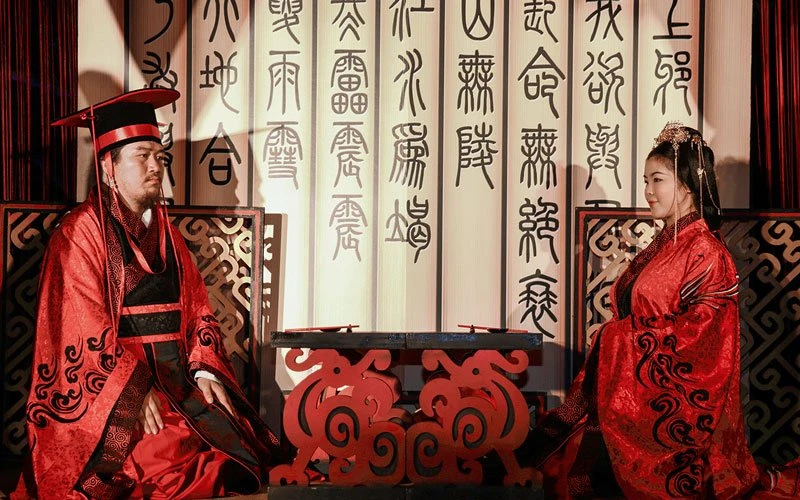
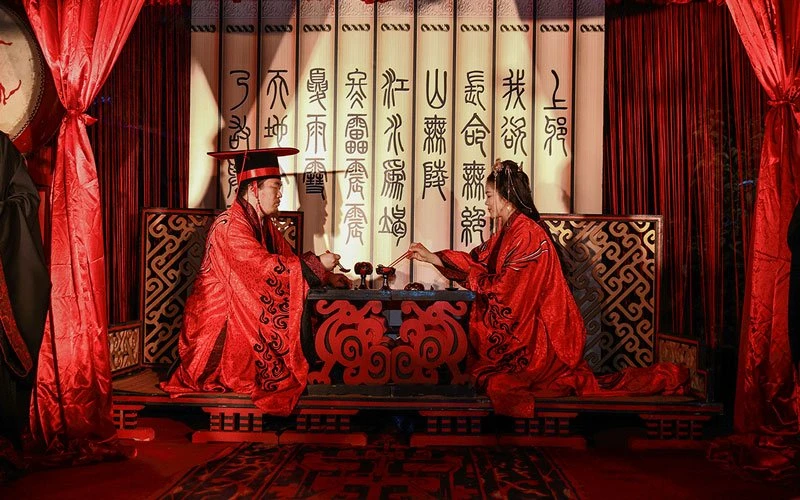

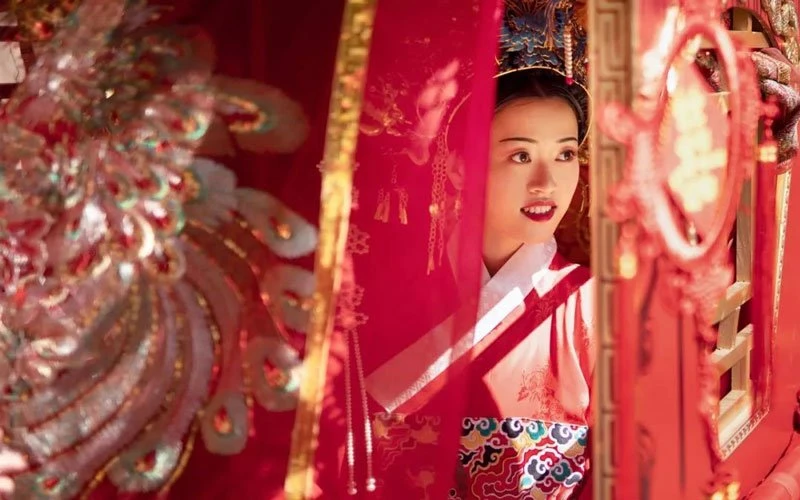
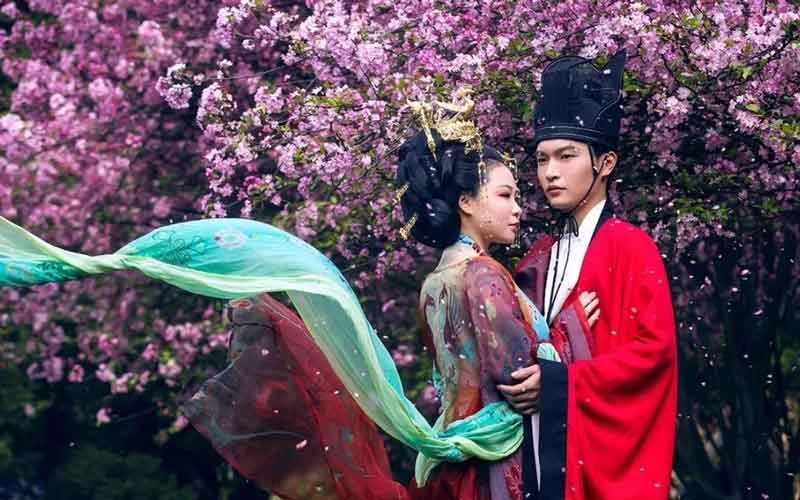


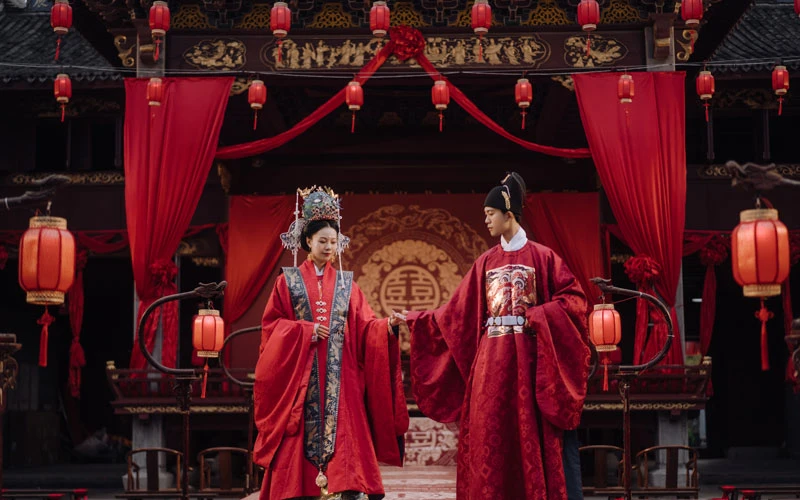

So detailed! Thank you!
Kalo aku nikah dengan gaya seperti ini pastinya orang2 pada geger,😂
Iya, di mana orang-orang nikah memilih gaya kebaratan 😂 apalagi dinasti Zhou, pengantin bajunya hitam 🤣